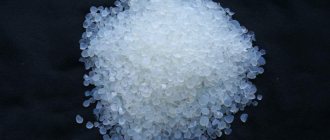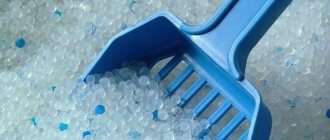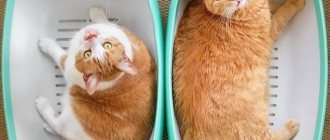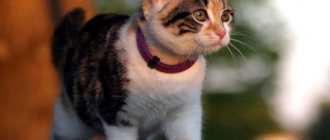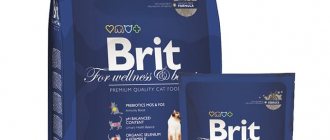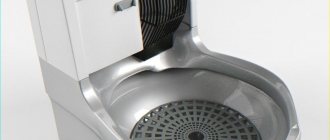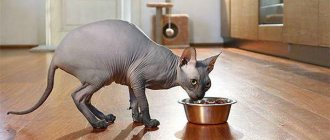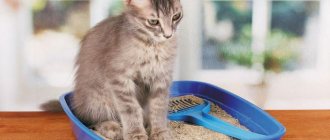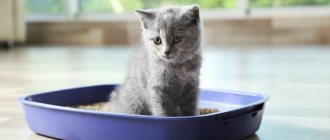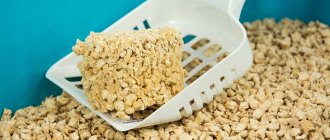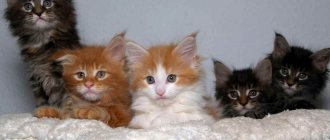Updated: 04/22/2021 17:12:38
Expert: Rudenko Irina Sergeevna
*Review of the best according to the editors of expertology.ru. About the selection criteria. This material is subjective in nature, does not constitute advertising and does not serve as a purchase guide. Before purchasing, consultation with a specialist is required.
A cat tray is an important attribute of keeping your animal clean. The type of litter used largely determines how quickly the animal will get used to its “household,” as well as how convenient it will be for the owners to maintain the tray.
Which tray to choose
At first, your kitten will need a litter box with low sides so that he can get in easily.
The container should be large enough for the animal to feel comfortable there and be able to use it more than once. If at the time the kitten appears in the house you have not yet managed to purchase a toilet for it, then an old baking dish or any other box may be perfect for this purpose. There are many varieties of indoor cat litter boxes on the market today, which not every animal wants to use. Experts advise using open trays first. In this case, during the period of accustoming the kitten to it, it will be easier for you to monitor it. Once he gets into the habit of using the litter box, you can place a closed one next to the open container to learn about his preferences. Some animals prefer the privacy of a closed box, while others do not like confined spaces.
If you have several cats, it is best to have one litter box for each of them, plus one extra. In a multi-story building, place a container on each level.
Which mixture should I choose for a kitten?
Since cats sometimes begin to eat all litter sprinkles, such mixtures are not recommended at all for pets under 4 months of age, especially silica gel or mineral ones. They can lead to the death of animals.
For babies over 4 months old, fillers with small balls are best. In this case, the tray should be deep and have a mesh so that the baby does not get his paws wet. You can put two different types into the toilet: wood on the bottom, mineral on top. If there is a mesh on top, then the kittens will not be able to reach the bedding to chew on it.
Cat behavior when using the toilet
In some cases, the cat completely refuses to use the toilet and does its business in the most unexpected places, while avoiding the tray itself or using it in an unusual way, for example, sleeping in it.
It is impossible to talk to a cat directly and find out its opinion on this issue, but the animal’s behavior can tell a lot to an attentive and caring owner.
Most cats that do not suffer from mental problems do not show dissatisfaction and go to the toilet with any litter. The exception is when the material contains any compounds that cause allergies in the animal. Then it cannot use its toilet purely physically.
In general, a cat’s requirements for litter can be outlined by the following points:
- the material should not contain any flavorings so that nothing distracts the animal’s keen sense of smell;
- the particles should not rustle loudly, knock or make any loud sounds, since cats prefer not to reveal their location to a hypothetical enemy during such an intimate process;
- It should be comfortable for the cat to dig into the tray; it is best if the filler particles are easily mixed and do not stick to the paws or raise dust;
- it is desirable that the material was natural, at least partially.
All cat owners are familiar with their pet's behavior in the toilet. These animals, with varying degrees of energy, dig out a place for themselves to relieve themselves, and then bury them. This behavior is due to the fact that all domestic cats descend from wild ancestors who were forced to take care of their own safety.
Most mammals on our planet navigate the world around them mainly by smell. Good eyesight or acute hearing are also inherent in some of them, but everyone smells smells, drawing from them the information necessary to choose a behavioral strategy. Excrement can tell a lot about an animal to another member of the fauna.
Domestic cats seem to have no need to perform this ritual and ensure safety, but almost all of them continue to bury their excrement. The cat teaches this to the kitten along with all other skills. It is a fixed behavioral pattern that animals continue to pass on from generation to generation, despite the fact that it has lost its practical value.
In addition, the genes of a cautious predator make cats constantly worry about survival and safety. Even a calm home environment, an always filled bowl does not make them careless, they are always ready to survive in any conditions
And they continue to follow the traditions learned from their mother.
Sometimes cats don't bury their excrement, and that should tell a sensitive owner a lot. There may be several reasons for a change in behavioral pattern. The cat may not hide evidence of his presence for the same reasons that in other conditions he carefully “destroys evidence.” It's about establishing your dominant role.
In most cases, this is due to the fact that there are several animals living in the house, especially if there are two or more mature cats. People call this behavior “marking territory”; it is for this purpose that cats leave their urine, saliva, feces, and rub against corners with glands that secrete odorous substances. This is how they establish their rights.
In some cases, cats stop burying feces for emotional reasons. If there are “clouds gathering” in the house, a difficult emotional situation, cats feel this very keenly. Then their behavior can change greatly, and they stop performing some usual actions, and, on the contrary, begin to behave in an unexpected way.
Quite rarely, but still sometimes cats are simply embarrassed to do their business in front of someone. Of course, the concept of shyness cannot be fully applied to cats. This behavior is due to the fact that when an animal is observed, it does not feel safe.
In such cases, we are not talking about a filler that we don’t like. It may be worth considering purchasing a closed litter box where your pet will be protected from prying eyes.
Preparing “toilet paper”: what is the difference between popular fillers
The cat is clean and smart, it does not need to be toilet trained, just show it once where the tray is. But in order to behave well, she must be provided with everything necessary. An important point: even a tray with high sides should preferably be located in a quiet and secluded place where the animal will have constant access.
Why is the choice of filler so important? Feces and bacteria parasitizing on cat urine have a very unpleasant odor. And this becomes a problem for kitten owners. Although, a completely solvable problem:
- You can choose a flat tray with pallet inserts. Now such cat litters are sold in any pet store.
- Purchase a scented litter that allows you to maintain a fresh smell from the moment of defecation until cleaning the toilet.
- Give preference to clumping litters.
In the first option, no filler is provided at all. But the owner is forced to wash the tray several times a day. What if there are several animals and each of them needs its own tray? After all, cats try to avoid other people’s smells and will not go to the same “potty.”
The only dubious advantage in this case is the low cost of the tray and the absence of the need to buy granules. But the disadvantages are more obvious: labor intensive and the constant smell of cat litter.
The second and third options are more acceptable for a kitten, although they require the purchase of more expensive trays with different design features - high sides, lack of a plastic mesh pallet. But the main detail is the hygienic filler, which you also cannot buy at random; you need to carefully select it.
The cat chooses litter for the toilet
Types of cat litter: mineral, silica gel, wood.
At home there was an open bag of sawdust, which we poured into the tray. But there it was. Our Mouse (and she was named that way because of the color of her fur) flatly refused to use these benefits of civilization. And we realized that she had never seen or known anything except sand in her life. I had to go outside to get sand.
She agreed to walk in the sand, but I didn’t really agree with this circumstance. This sand was carried on its paws throughout the apartment, and since our girl chose the sofa in the living room for the rookery, there were “piles” of sand on it. Then we decided to replace the sand with pieces of wood, but sprinkle a little sand on top. It helped.
Slowly they got rid of the sand completely. But again, bad luck - the debris from the soaked sawdust also spread on its paws throughout the entire space of the apartment, and after a couple of days the pot itself emitted a specific “aroma”.
Wood fillers
They are made from wood waste from the processing of pine, spruce and, less commonly, fir. They are granules that, when exposed to moisture, swell and crumble into small components.
Due to their low cost, wood fillers are in good demand and popularity. Many people prefer this type of filler because of its naturalness. Wood filler is safe for animals, especially kittens.
The wood of pine trees contains resins, which give the wood filler antiseptic properties. After use, the filler can be applied as fertilizer.
It absorbs moisture quite well and eliminates odors, but these indicators are lower than those of other types of fillers, so the filler needs to be changed more often; it is consumed faster.
Another drawback is lightness. When burying, the cat can scatter it around the tray, so you need a deep tray with sides rounded inward.
Scattering into fine dust, it sticks to the paws and spreads throughout the apartment.
If you prefer this type of filler, guided by considerations of naturalness, safety and cheapness, then it would be a good idea to purchase a special closed toilet with a mat.
The walls of the closed toilet will not allow the cat to scatter the litter around the tray, and the mat will clean the paws from adhering particles and prevent them from being dragged around the apartment.
When using this filler, a tray with a grid is also convenient; whole granules will remain on the surface, and the used ones will be sifted through the grid into the tray.
Wood filler differs from other types of fillers in its ease of disposal. It can be flushed down the toilet. To avoid clogging, rinse off the filler in small portions.
Wood filler: pros and cons
Pros:
- LOW PRICE
- ECOLOGICAL CLEANNESS
- USE FOR KITTENS
- EASY TO DISPOSAL
Minuses:
- HIGH CONSUMPTION
- STICKS TO FEET
- REQUIRES FREQUENT REPLACEMENT
Fillers made from corn and paper are similar in properties and price to wood fillers.
Mineral fillers
Mineral fillers are somewhat more expensive than wood fillers and are also in high demand.
The ability of mineral fillers to absorb moisture and retain odors is better than that of wood fillers.
They are made from natural mineral raw materials - soft clay minerals and hard minerals from sedimentary and volcanic rocks. There are also artificial mineral fillers made from sibit.
In addition to the starting material, mineral fillers differ in:
- The method of absorbing and retaining moisture – clumping and absorbent fillers;
- Granule size – large, small and medium granules;
- Availability of flavoring additives – flavored and non-flavored.
The disadvantage of this type of fillers is their dustiness. During transportation, the granules rub against each other, forming fine dust, which can cause allergic reactions.
Higher quality fillers have a denser consistency and generate less dust.
What is the difference between absorbent and clumping litters?
Absorbent fillers absorb moisture through the entire surface of the material from which the filler is made, without forming lumps. The absorbency is due to the porous structure of the mineral.
Such minerals, for example, include zeolites, which perfectly absorb moisture and insulate odor.
The activity of the absorbent filler is lost gradually. From time to time, it can be mixed to evenly distribute more active and less active granules.
The absorbent filler is replaced at once, that is, the used filler is completely removed, and a fresh portion is poured into the tray, in the volume indicated on the packaging.
Clumping fillers not only have absorbent properties, their granules, when moistened, stick together into a lump, isolating the wet area from the rest of the filler.
A complete replacement of the filler is not required; it is enough to remove the formed lumps with a special spatula. The filler is poured into the tray as needed.
They are made mainly from bentonite clays of different compositions. During the manufacturing process, they can be subjected to thermal or chemical treatment to improve quality.
Natural mineral fillers have antibacterial properties.
Which filler is better at removing odor, absorbent or clumping?
Both fillers cope with odors approximately equally well, but do it in different ways.
Clumping, enveloping the wet area, locking the smell inside the coma. Absorbents, due to their porous structure, are able to absorb urine and neutralize its odor through ion exchange reactions, then evaporating clean water.
Among both there are more and less quality ones, it depends on the composition of the raw materials and production technology.
According to the results of the television program “Test Purchase”, out of 10 popular brands of clumping litter, first place went to the “Pretty Cat” brand. Second and third, fillers from the “Clean Paws” and “Catsan” brands.
Mineral filler: pros and cons compared to wood filler
Pros:
- ABSORBES LIQUID BETTER THAN WOOD;
- BETTER ABSORB ODOR;
- MORE ECONOMICAL AND CONVENIENT USE;
- DOES NOT SPREAD AROUND THE APARTMENT;
Minuses
- MORE EXPENSIVE;
- DUSTY WHEN POURED;
- NOT DISPOSED THROUGH THE TOILET.
Silica gel filler
Silica gel litter is the most modern, highly effective and practical litter for cats.
- Its cost is quite high and, perhaps, this is the only reason that does not allow it to displace all other types of fillers from the market.
- It consists of white translucent crystals with the addition of a substance that eliminates unpleasant odors.
- The granules can be irregular or regular round in shape. Among the white granules, granules of other colors may be present in small quantities.
- They act as an indicator - when urine comes into contact with them, they change color. By their number in the filler, the owner can determine when it is time to replace the filler in the tray.
- The absorption capacity of silica gel is extremely high, and it completely eliminates all odors. Silica gel is very economical, a small amount is enough for two or three weeks for one cat.
- Although expensive, this litter can be cost-effective if you have multiple cats in your home.
- Has an aesthetic appearance.
- Among the disadvantages, in addition to the high price, it is necessary to note the specific crunch that the filler makes during use. Some cats find this crunching sound frightening.
Selico-helium filler advantages:
ECONOMICAL CONSUMPTION
Minuses:
HIGH PRICE
How often should I change the litter in the tray?
How often to change the litter in the litter box will directly depend on the type of litter, as well as how many cats you have, what gender they are and what is currently happening to them.
For example, cats pee very often during estrus - and the litter box needs to be removed as urine accumulates.
Article continues after advertisement
If there is more than one cat in the house, but there is a common litter box, then no matter how good its “filling” is (except for silica gel), it will have to be changed every day. Not the whole thing, of course, but only the contaminated part.
In the usual case, when your cat lives in splendid isolation and reigns supreme over the litter box, most often you need to sort through the wooden one, because... it doesn't hold the smell. It is advisable to do this once a day. Clumping clay can be sorted out once every 2-3 days. You just need to sift the clumped part with a scoop and add a little new sand, that is, you don’t need to change everything. Silica gel lasts longer than others, which is changed approximately once every 7 days if there is only one cat, but the whole thing needs to be changed. That is, do not sort through the waste, but simply pour out the old and add in the new.
Pros and cons of different types of filler
There are so many types of fillers! They can be ordinary sand and paper. You can buy wood, mineral, or silica gel granules for filling your cat's litter box at the pet supply store and most supermarkets. All these varieties perform the same functions. Moreover, each of them has certain advantages and disadvantages, the study of which will greatly facilitate the choice of litter for a small pet’s toilet.
Classic: sand
Sand began to be used as cat litter when there were no ready-made, easy-to-use analogues. Its advantages are:
- availability, although it is not so easy for city residents who keep cats to find this bulk material;
- absence of foreign odors and harmful components in the composition;
- lack of ability to dust.
The disadvantages of this filler include:
- Low absorbency.
- The inability to absorb odors emanating from the waste products of four-legged users of the tray, which leads to the need to frequently change its contents.
- A small fraction, fraught with the fact that if a kitten accidentally inhales grains of sand, he may die by suffocation. If a small pet has long fur, when visiting the toilet, the smallest particles of such filler will become entangled in it and will have to be combed out.
- Inability to flush down the toilet.
Scraps of paper
Filling the cat's litter box with scraps of paper (for example, newspapers) does not require any costs, since today many publishers distribute these printed publications for free. The advantages of this type of filler include:
- safety;
- absence of foreign odors and tendency to dust;
- cheap (if you fill the tray with toilet paper, you still have to spend money);
- the ability to flush down the toilet (preferably in small portions, otherwise the drain will clog).
The disadvantages of this method of filling cat litter include:
- Low absorbency. If you use paper scraps, there is a high chance that your kitten's paws will come into contact with urine after urinating.
- The need for frequent filler replacement.
- Inability to absorb odor, which means you will have to clean the tray after each visit by the animal.
Wood filler
Wood pellets, consisting of compressed sawdust, are one of the most popular types of cat litter. Its popularity is due to the fact that it:
- has low cost;
- absorbs moisture well and absorbs unpleasant odors;
- absolutely harmless due to its natural composition;
- hypoallergenic, which allows the use of wood filler for pets with allergies or animals prone to allergies;
- Available in the form of large and small granules;
- has a pleasant natural woody aroma;
- does not clog the drain when flushed into the toilet;
- does not generate dust;
- has economical consumption - when wet, the granules greatly increase in size, so it is enough to cover only the bottom of the tray with them.
Mineral granules
Mineral granules made from pieces of clay are accessible and absorb moisture well, clumping together, which makes cleaning the tray very convenient - just use a special spatula to remove the wet material. However, they have significant drawbacks. This type of filler:
- does not absorb odors well (to solve this problem, manufacturers use fragrances in the production of mineral granules, which repel many cats with their unnatural aroma);
- very dusty;
- sticks to the paw pads of animals, spreading throughout the home;
- Do not flush it down the toilet, otherwise the drain will clog.
Silica gel filler
Advantages of filler in the form of synthetic granules:
- moisture capacity;
- ability to absorb unpleasant odors;
- economical consumption;
- does not generate dust.
Cons of silica gel granules:
- quite high cost - this is the most expensive filler of all;
- hissing upon contact with moisture, which not all animals like, some of which refuse to go into a tray filled with this material;
- the ability to spread throughout the home, getting stuck in the cat’s fur.
The most significant disadvantage of this litter is that if a kitten accidentally swallows it, the particles will begin to absorb the moisture inside it. If the baby does not drink water on time, swallowing synthetic granules can end sadly for him. It is for this reason that the use of synthetic and artificial fillers is prohibited in some European countries.
Rating of the best silica gel fillers
| Nomination | Place | Name | Price |
| The Best Silica Gel Cat Litters | 1 | Fresh Step Crystals | 800 ₽ |
| 2 | Smart Cat | 397 ₽ | |
| 3 | Homecat Silica Gel Standard | 281 ₽ | |
| 4 | N1 Crystals | 257 ₽ | |
| 5 | Cat Step | 295 ₽ | |
| 6 | PRETTYCAT | 125 ₽ | |
| The best clay cat litters | 1 | Ever Clean Multi-Crystals | 770 ₽ |
| 2 | Fresh Step Extreme Clay | 429 ₽ | |
| 3 | Canada Litter Scoopable Baby Powder | 520 ₽ | |
| 4 | Happy paws | 171 ₽ | |
| 5 | Eurolitter Baby Powder | 632 ₽ | |
| 6 | ProNature Holistic | 690 ₽ | |
| 7 | Kotyara | 164 ₽ | |
| The best wood litter for cat litter | 1 | Cat's Best Eko Plus | 350 ₽ |
| 2 | N1 Naturel Green tea | 383 ₽ | |
| 3 | Clean paws Woody | 142 ₽ | |
| 4 | Homecat Wood small granules | 99 ₽ |
What are the types of fillers?
When choosing litter for your cat, do not immediately purchase large-volume packaging - it may happen that for some reason your pet does not like this product. First, buy the smallest bag and test a certain type of filler in practice.
Don't buy a large bag of filler
According to the operating principle
All tray fillers are divided into two large groups: clumping and absorbent. Each of these types has both its advantages and disadvantages.
Clumping
Upon contact with a liquid filler of this type, moisture penetrates into the porous granules and sticks them together. This creates small hard lumps that are very easily removed from the tray. Thanks to this, the filler does not require complete replacement, but only partial cleaning, which ensures the cost-effectiveness of this product. Low-quality, cheap fillers clump much worse and also do not retain odors well.
Dense lumps of filler are easy to remove from the tray
Absorbent
Wood absorbent fillers are very popular - primarily due to their low cost and natural composition. Mineral fillers “work” more efficiently than wood fillers - they absorb moisture and specific odors better, retain them longer, and are not much more expensive
It is worth paying attention to the quality of mineral fillers - the simplest and cheapest of them, when wet, turn into an unpleasant-looking slurry that contaminates your pet’s paws and spreads throughout the house
Cats usually like wood litter
Most absorbent fillers have a common drawback - they generate dust when poured into a tray. Small particles from the air enter the cat's lungs and can cause an allergic reaction. This phenomenon occurs because during storage and transportation, soft granules rub against each other and are partially destroyed, turning into fine and light dust.
By composition
All fillers are different in their composition, as are the preferences of cats in this delicate matter.
And in the end, the final decision on choosing such an important product will be made by your pet. And your task is to tactfully push him to the right decision, for which you will have to study what types of fillers there are in terms of their composition, what are their advantages and disadvantages
Fillers of different compositions “work” differently in the tray
Table: pros and cons of various compositions for cat litter
| Filler type | Compound | pros | Minuses |
| Mineral | crushed minerals of volcanic origin |
|
|
| Clay | granules from European and Asian bentonite clays |
|
|
| Woody | flakes or granules from plant fibers - wood of various species |
|
|
| Silica gel | crystalline granules of dried silica gel - silicon oxide |
|
|
| Corn | crushed corn cob granules |
|
|
| Herbal | dried and pressed into granules meadow grasses |
|
|
Recommendations for selection
The most affordable is wood litter, and most cats respond well to it. A clumping mineral and clay product is considered the most natural. Silica gel is one of the more expensive, but also more economical fillers.
The market is full of offers, so making a balanced and correct choice is especially important. If the animal does not like the filler, it will refuse to use the toilet and will be very distrustful of the new product.
Let's look at the main criteria that need to be taken into account.
Choose filler from well-known companies. In this case, you will be able to accurately understand that the quality and environmental friendliness of the product is controlled by both manufacturers and buyers.
For a kitten, use litter without aromatic ingredients. Experts recommend choosing this option for adult animals as well, because finding a suitable scent can be quite problematic.
Consider the animal's habits. If a cat was accustomed to silica gel in a cattery, then wood filler may cause the cat to refuse the tray.
Choose a product that has the appropriate labeling about the absence of chemical treatments and additives, and about environmental safety
When an animal digs into the litter with its paws, dust enters the respiratory system, and particles enter the digestive system. It is important to ensure the cat’s safety.
When assessing the cost of filler, take into account its cost-effectiveness. A cheap product that needs to be replaced frequently will result in higher total costs than an expensive product that can be replaced less frequently.
The large size of granules is mainly chosen for long-haired adult cats. Fine filler can get stuck in the fur and cause discomfort to the animal.
